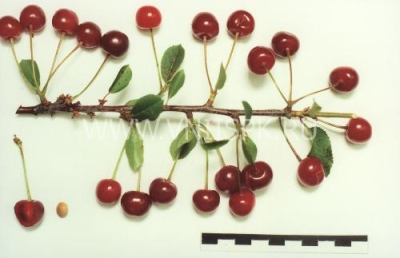
- Authors: Kolesnikova Adelina Frolovna, Zhdanova Galima Badrievna (All-Russian Research Institute of Breeding of Fruit Crops)
- Appeared when crossing: No. 11 x Consumer black
- Year of approval: 1986
- Barrel type: wood
- Growth type: medium-sized
- Crown: raised, reverse pyramidal, medium density
- Escapes: medium, straight, brown
- Leaves: obovate, green
- Flowers: narrow-rounded
- Flowering and fruiting type: on bouquet twigs and growths of the last year
The same age is an ordinary cherry variety, bred by specialists of the All-Russian Research Institute of Selection of Fruit Crops. The "parents" of the Age group can be considered varieties No. 11 and Black consumer goods. The variety has been used since 1986, so all the features of its agricultural technology have already been well studied.
Description of the variety
The tree is small, medium-sized, grows about 3 m in height. The crown of medium density, raised, is formed in the form of an inverted pyramid; leaves are wide, green, glossy, their surface wrinkles, and their shape resembles an egg. The flowers are narrow-calcified, up to 4 flowers are formed in the inflorescence, during the flowering period they are formed on bouquet branches and last year's growths.
Fruit characteristics
The berries are small, round, the size is 13x13x13 mm, and the weight is only 3-3.5 g. Covered with maroon skin, hiding dark red juicy pulp.
Taste qualities
Roesnitsa berries have a delicate, rich, sweet and sour taste. Taste qualities are estimated at 4.6 points. The fruits can be used both fresh and for making compotes, jams, preserves. The berries are perfect as a filling for a pie, especially since their small bone is very easily separated from the pulp, which greatly simplifies and speeds up cooking.
Ripening and fruiting
The first fruits appear 4 years after planting. Flowering begins in the second half of May, and the harvest usually falls on July 12-15, that is, it is a late ripening variety. All berries ripen at the same time.

Yield
The Rovesnitsa variety belongs to the productive varieties of crops and gives an average of 40 c / ha, the maximum possible number of berries is 64 c / ha.
Self-fertility and the need for pollinators
This is a partially pollinated variety, next to it it is recommended to plant other crops with the same ripening period, for example, Turgenevka cherry, Vladimirskaya and other varieties that will take on the role of a pollinator.
Landing
Pay special attention to the choice of a site for planting a plant.
It should be a flat surface or a slight slope to the south.
The site should be well lit by the sun, but hidden from the wind.
More comfortable Coves will feel in loams and sandy loams with neutral acidity.
The planting process is as follows.
2-3 weeks before the day of disembarkation, prepare a hole with a diameter of 70 cm and a depth of 80 cm.
Place a drainage layer, such as rubble, on the bottom.
Fill in the nutrient mixture: humus with compost or black soil with peat.
Cover the remaining space with sand.
A few hours before planting, soak the roots of the seedling in a solution of "Zircon".
Plant it on the finished site by tying it to a peg. Make sure that the root collar remains on the surface.
Water the planting site with 20-30 liters of water and mulch.


Growing and care
The Rovesnitsa variety has good drought resistance, so you can limit yourself to a minimum amount of watering. It is enough to moisten the ridge 3-4 times per season. Do not forget about fertilizers: apply organic and nitrogen mineral fertilizers in the spring, and superphosphates in the fall.
It is better to form a tree in a bushy form. Place skeletal branches 15 cm apart. The first 3-4 years are allowed to keep 10-12 skeletal branches.
The presented variety cannot boast of good winter hardiness, but if you wrap the trunk with breathable fabric material, then the plant will survive the cold season quite comfortably.


Disease and pest resistance
The variety Covesnitsa is relatively resistant to coccomycosis and can be affected by moniliosis. To avoid these ailments, treat the tree with chemicals in the fall and early spring. These actions will not only prevent the development of diseases, but also scare away insects.
































































